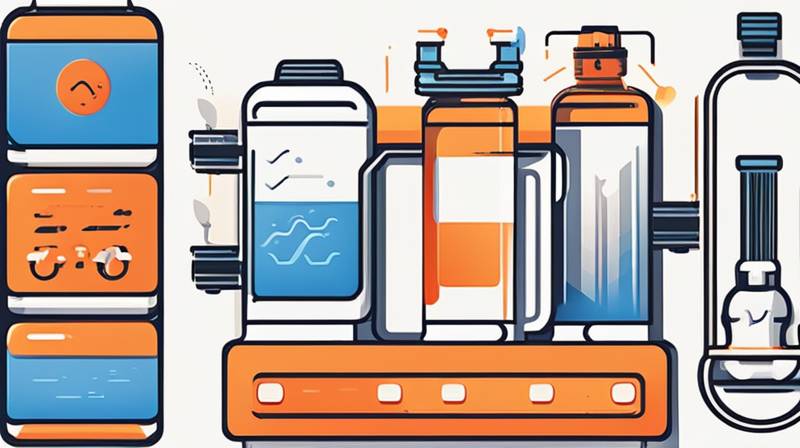
Liquid vanadium energy storage systems achieve high efficiencies due to several pivotal factors: 1. Outstanding energy density, 2. Extended cycle life and durability, 3. Operational flexibility, 4. Minimal environmental impact. The outstanding energy density is particularly noteworthy, as the capacity to store energy effectively allows for streamlined energy management, minimizing losses and enhancing overall system performance. Such energy storage solutions also offer the advantage of longevity, with the capacity to withstand numerous charge and discharge cycles without significant degradation. As renewable energy sources proliferate, liquid vanadium systems emerge as a viable alternative, providing a robust mechanism for energy stabilization.
1. UNDERSTANDING LIQUID VANADIUM
Liquid vanadium energy storage systems primarily utilize vanadium redox flow batteries (VRFBs). This innovative technology leverages the unique chemical properties of vanadium ions in multiple oxidation states, enabling effective energy conversion during recharge and discharge cycles. By employing a liquid electrolyte containing these vanadium ions, VRFBs facilitate a continuous flow, allowing for smooth energy transfer.
In contrast to conventional solid-state batteries, liquid vanadium systems possess a modular design. This modularity results in scalability; as demand for energy storage increases, additional storage capacity can be integrated seamlessly. Moreover, the ability to separate energy storage capacity from power generation enhances the system’s operational flexibility. Users can optimize their setup in accordance with specific energy requirements, facilitating a more tailored approach to energy management.
2. ENERGY STORAGE EFFICIENCY
The energy storage efficiency of liquid vanadium systems typically hovers around 75% to 85%. This range indicates how effectively the system can convert stored chemical energy back into electrical energy. Several factors contribute to achieving these efficiency levels, including the electrochemical characteristics of the vanadium ions, system design, and operational conditions.
Electrochemical efficiency primarily stems from the redox reactions involving vanadium ions during discharge and charge cycles. High electrochemical stability is crucial in ensuring minimal energy losses. Furthermore, exceptional thermal management systems in these setups play a vital role in maintaining optimal operating temperatures, which directly impacts performance and efficiency. Uncontrolled temperatures can lead to increased resistance within the system, ultimately lowering efficiency levels.
3. COMPARATIVE ANALYSIS WITH OTHER STORAGE TECHNOLOGIES
When juxtaposed with other energy storage technologies, such as lithium-ion batteries, liquid vanadium systems hold distinct advantages, particularly in large-scale applications. Lithium-ion batteries might offer high energy densities in compact formats, yet they face limitations regarding cycle life and thermal stability. In contrast, VRFBs exhibit remarkable cycle life, typically exceeding 10,000 cycles without significant capacity loss.
Moreover, environmental concerns accompany lithium-ion technologies due to the mining and processing of raw materials. Liquid vanadium systems exhibit a considerably smaller environmental footprint, as their primary components are abundant and sustainable. The recycling capabilities of vanadium further amplify their eco-friendly qualities, signifying a more sustainable option for large-scale energy storage solutions.
4. APPLICATIONS OF LIQUID VANADIUM ENERGY STORAGE
Liquid vanadium energy storage systems find applications across various sectors, including renewable energy integration, grid stabilization, and electric vehicle charging infrastructure. In renewable energy, they serve as pivotal components for efficient energy management throughout fluctuations in production, ensuring a consistent supply even during periods of low generation.
Grid stabilization, specifically, necessitates the ability to store surplus energy during peak production hours. By deploying VRFB systems, grid operators can mitigate challenges related to grid reliability and integrate renewable sources more efficiently. This reliability proves indispensable in a world increasingly reliant on renewable energy to meet growing consumption needs.
FREQUENTLY ASKED QUESTIONS
WHAT ARE THE ADVANTAGES OF LIQUID VANADIUM ENERGY STORAGE SYSTEMS?
Liquid vanadium energy storage systems offer multiple advantages. First, their long cycle life minimizes the need for frequent replacements, ultimately reducing operational costs. Second, they provide substantial energy storage capacity while maintaining safety during operation. Finally, the modular nature of these systems allows for tailored solutions, accommodating varied applications and energy requirements.
HOW DOES LIQUID VANADIUM CONTRIBUTE TO RENEWABLE ENERGY USE?
The use of liquid vanadium systems significantly boosts renewable energy utilization. By storing excess energy generated during peak production hours, these systems facilitate steady energy delivery during periods of low production, such as at night or on cloudy days. Additionally, they assist grid operators in balancing energy supply and demand, ensuring sustainable energy practices and enhancing the stability of green energy sources.
CAN LIQUID VANADIUM SYSTEMS BE INTEGRATED WITH OTHER TECHNOLOGIES?
Indeed, liquid vanadium energy storage systems exhibit impressive compatibility with various technologies. For instance, they can work in conjunction with solar panels and wind turbines, effectively absorbing and distributing surplus energy. This integration enhances overall system efficiency and expands renewable energy adoption, creating a more sustainable and reliable energy grid.
The advancements and applications of liquid vanadium energy storage represent a significant stride toward optimizing energy management. Leveraging the inherent properties of vanadium enables these systems to deliver exceptional efficiency, cycle life, and environmental sustainability. Their ability to facilitate the integration of renewable energy sources signifies a pivotal role in achieving global energy goals. By investing in liquid vanadium technology, industries and municipalities can bolster energy reliability while promoting sustainability. As more stakeholders recognize the potential of liquid vanadium systems, the transition toward cleaner energy solutions will gain momentum, furthering global efforts to mitigate climate change and ensure a greener future. The advantages of scalability, long lifespan, and minimal environmental impact ensure that liquid vanadium will increasingly play a crucial role in the energy landscape. In summary, the pursuit of higher efficiency and sustainable energy practices is fundamentally anchored in the evolution of liquid vanadium technologies, making them an invaluable asset for future energy strategies.
Original article by NenPower, If reposted, please credit the source: https://nenpower.com/blog/how-is-the-energy-storage-efficiency-of-liquid-vanadium/


